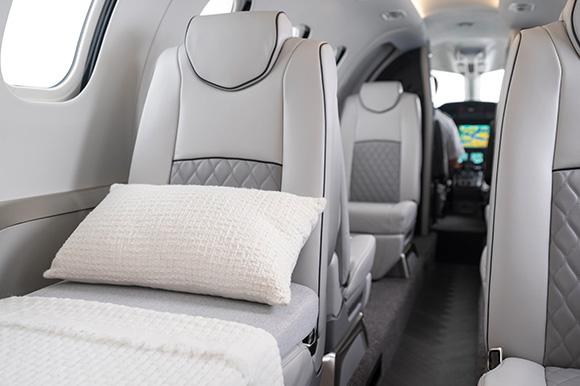
LAS VEGAS—Honda Aircraft formally launched the HondaJet Echelon Model HA-480 light jet program during NBAA-BACE, announcing it has signed more than 350 letter of intent and providing additional details about its design.
With a transcontinental range of 2,625 nm with one pilot and four passengers, the aircraft offers midsize performance in a light jet, says Hideto Yamasaki, Honda Aircraft Co. president and CEO.
Honda Aircraft unveiled the design as a concept aircraft at NBAA-BACE in 2021. Since June, when the company announced its decision to commercialize the program, it received additional letters of intent numbering more than 50, officials say.
“There is significant traction in the market,” says Amod Kelkar, Honda Aircraft chief commercial officer and HondaJet Echelon program leader. A mockup is on display with the HondaJet Elite II jet at Henderson Executive Airport.
The company is aiming for the aircraft to receive an amendment to the type certificate of its HondaJet Elite II because the two aircraft have many design similarities. A common type rating will allow pilots to fly both aircraft. As with the HondaJet Elite II, the Echelon will be equipped with Garmin G3000 avionics. It also will be equipped with autobrakes, a runway overrun awareness and alerting system, an advanced augmentation system, autothrottle and Garmin’s emergency Autoland, which automatically lands an aircraft in the event the pilot becomes incapacitated.
The HondaJet Echelon will have an all-new fuselage, which will be 4.5 in. taller and 1 in. wider than the HondaJet Elite II, with 5.5 in. of additional room at shoulder height and 7 in. more room across the bottom of the seats for additional legroom.
Customers will have a choice of three seating configurations, including an executive version, dual club or divan. The company is working with Honda North America Automotive Design on the Echelon’s interior.
First flight is expected in 2026 with certification in 2028. Fabrication has begun at Honda Aircraft’s headquarters in Greensboro, North Carolina, with critical design review scheduled for completion in mid-2024, officials report.
Honda Aircraft is designing the Echelon with sustainability in mind, part of the company’s corporate social responsibility, Yamasaki says.
The company has not yet settled on a price for the aircraft, which is the reason it has not turned the letters of intent into firm orders, Yamasaki says. They are currently considering a variety of factors before coming to a decision.
Honda Aircraft selected Wichita-based Spirit AeroSystems as the supplier of the aircraft’s carbon fuselage. Honda Aircraft has finalized the set of drawings and designs for the fuselage, which have been transferred to Spirit. The supplier is now in the process of turning them into manufacturing drawings; it also has the drawings for the tooling and has begun to build the tooling to produce the fuselage, says Kelkar.
Selecting Spirit AeroSystems is a departure from its fuselage supplier for the HondaJet Elite, which is GKN, based in South Carolina. GKN is in the process of moving production to Chihuahua, Mexico. Starting in 2024, the fuselage will be built there, Kelkar says.
Adding the HondaJet Echelon to the product line will mean significant growth in its workforce over time. First, Honda Aircraft will expand its engineering resources followed by growth in its manufacturing workforce.
Honda Aircraft’s biggest challenge remains supply chain recovery, Kelkar says. The key suppliers in aviation are nearly the same for all aircraft manufacturers, so it is an issue shared among all.
“There is a gradual improvement,” he says. “There is a little bit of a raw material shortage problem in certain aspects, but I would say mainly, manpower seems to be the biggest challenge. And even for us, when you look at building airplanes, supporting airplanes, maintaining airplanes throughout our network, manpower is a challenge at the moment.”
In the meantime, the market is strong. When the pandemic hit, business aviation soared. While it has moderated, demand is still higher than pre-COVID levels and order backlogs remain stable, Yamasaki says.
“Everybody was expecting that business aviation will slow down at a much faster rate, but it did not happen,” he says. “It only went to 85% of the peak . . . which is telling news because that tells you that business aviation just became stronger out of this whole COVID episode.”
The crisis with Israel and the war in Ukraine, however, are beginning to affect Honda Aircraft and other business aviation companies who rely on suppliers that also supply the defense industry, Yamasaki says.
“What happens is sometimes when you’re trying to modify an in-service product, the same supplier still has to cater to this increased demand from governments,” he says. “It’s not just us—all aircraft OEMs are facing exactly that. Hopefully, everything will be resolved, very, very soon.”
